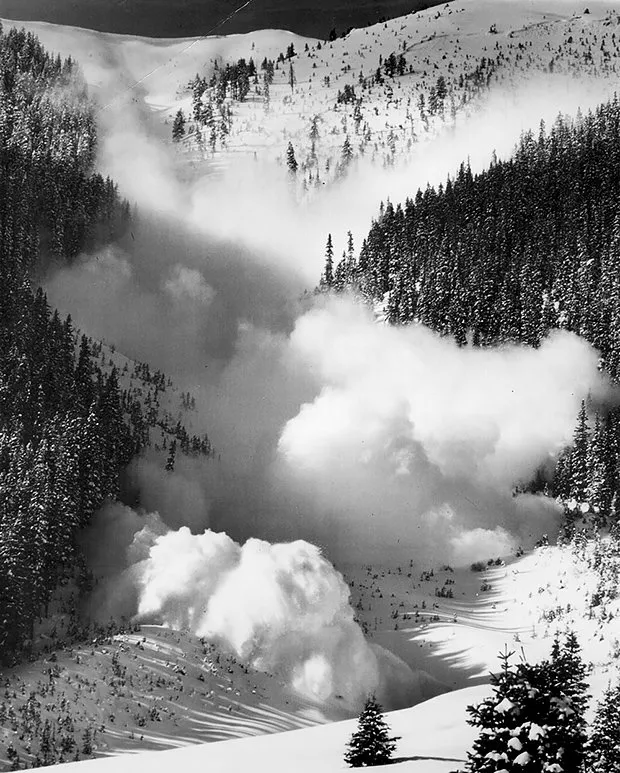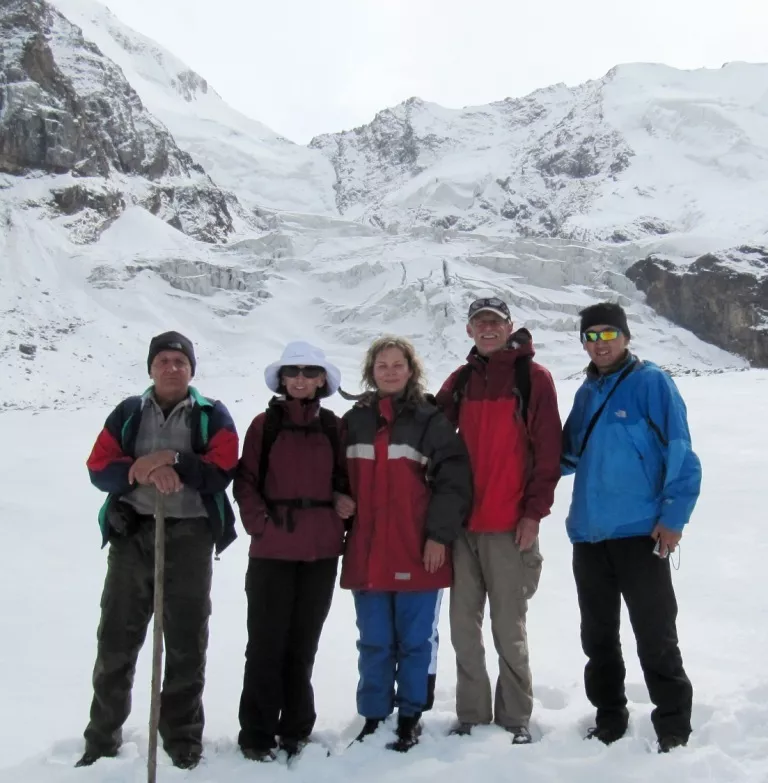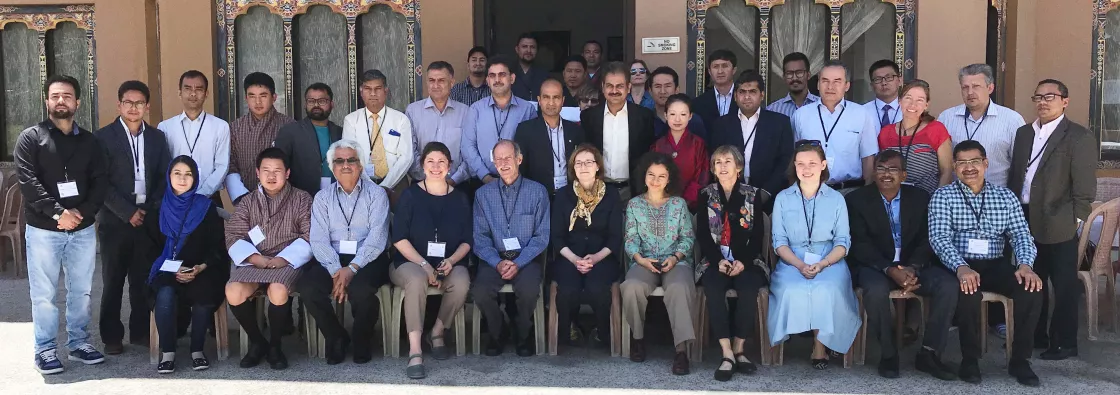By Michon Scott
Long-time National Snow and Ice Data Center (NSIDC) scientist Richard Armstrong died August 3, 2023. He is remembered with admiration by colleagues and friends around the world.
Armstrong was one of NSIDC's first scientists, joining the data center in 1985. Much of his early work focused on building partnerships between NSIDC and other World Data Centers for Glaciology. While his own research focused primarily on snow and glaciers, he also collaborated with and mentored researchers investigating every facet of the cryosphere, from sea ice, permafrost, and other geophysical features to innovative applications of remote sensing. From 2008 to 2009, he acted as NSIDC’s interim director between the retirement of Roger Barry and the appointment of Mark Serreze, and served as director of the Cooperative Institute for Research in Environmental Sciences Cryospheric and Polar Processes Division for several years.
After earning his bachelor’s degree in geography in 1967, Armstrong worked as a field geologist for the University of Washington Blue Glacier Project and the Institute of Arctic and Alpine Research (INSTAAR) San Juan Avalanche Project, which he directed from 1972 to 1986. He also forecast avalanche activity for the US Forest Service from 1980 to 1984. Meanwhile, he earned a master’s degree in glacier mass balance in 1976, and a PhD in snow physics in 1985, both from the University of Colorado Boulder.
At NSIDC, Armstrong continued to pursue research on snow and glaciers, authoring over 100 peer-reviewed papers about the cryosphere and remote sensing. He developed NSIDC data sets on snow extent and snow water equivalent that spanned decades. For many years he was principal investigator of the NASA-funded Global Land Ice Measurements from Space (GLIMS) data set to inventory world glaciers and their changes over time. In 2007, he contributed to the Intergovernmental Panel on Climate Change (IPCC) report, Climate Change 2007: The Physical Science Basis. The IPCC and former Vice President Al Gore received the Nobel Peace Prize in 2007 for research and reporting on climate change.
Throughout his time at NSIDC, Armstrong showed a talent for finding new opportunities to expand research and share knowledge. He realized in the 1990s, while working with the NOAA/NASA Polar Pathfinder data, that non-cryospheric scientists could use gridded passive microwave temperatures outside the polar regions. The resulting planet-wide grids supported the advancement of other research disciplines. When Armstrong realized he could not easily find answers to snow and ice questions that he fielded at a cross-disciplinary science meeting, he launched one of NSIDC’s earliest analysis webpages, State of the Cryosphere. He provided the scientific expertise behind NSIDC’s early education webpages, such as All About Glaciers and Avalanche Awareness. Content from these webpages remains available in NSIDC’s updated Learn content.
Armstrong’s unflagging energy and commitment frequently awed his colleagues. In one instance in 2009, he coauthored a handout to be delivered by the Foreign Minister of Norway at the United Nations Climate Change Conference (COP15). He completed the work in just two days—two days that immediately followed his visit to Kathmandu to discuss climate change risks at a meeting sponsored by the World Bank Group.
The capstone of Armstrong’s career was the Contribution to High Asia Runoff from Ice and Snow (CHARIS) project. Before initiating the project, the US Agency for International Development (USAID) asked Armstrong for a 10-page report summarizing the state of glaciers in the Hindu-Kush-Himalaya, Pamir, and Tien Shan Mountain Ranges. Armstrong’s wife and long-time science collaborator, Betsy Armstrong, recalled, “Everybody else said, ‘No, you can't do that in 10 pages.’ And Richard said, ‘Yes, I can.’” He submitted a succinct report, starting the process that made CHARIS a reality.
CHARIS focused on determining how much of High Asia’s water comes from glaciers and how much comes from snowmelt, in a part of the world where more than a billion people derive all their water from the region’s rivers. The project combined assessments of water resources with training of new researchers to continue the work. Armstrong prepared for CHARIS by traveling to Central Asia to find international partners, visiting Tajikistan, Uzbekistan, Kazakhstan, and Kyrgyzstan. Over the course of the project, he continued his frequent travel, spending time in Nepal, Bhutan, and India, and collaborating with researchers across High Asia.
CHARIS involved researchers at 11 institutions in eight nations. Many High Asia researchers had not previously worked together because of a lack of resources, disputed borders, and opposing outlooks. Armstrong derived great satisfaction from observing easing tensions between participants over the life of the project. In 2022, Richard Kelly of the University of Waterloo reflected on Armstrong’s CHARIS contributions, citing his ability to map and monitor water sources while reducing tensions over water supplies to meeting competing demands and changing climates. Rijan Bhakta Kayastha of Kathmandu University praised Armstrong’s lasting impact on students and professional glaciologists in the region, who formed partnerships with each other beyond the CHARIS project.
Armstrong is remembered not only for his scientific achievements but also for his generosity and mentorship of his colleagues. NSIDC Senior Associate Scientist Mary Jo Brodzik said, “Richard single-handedly changed my career trajectory. I took a job with NSIDC in 1993, thinking I’d be here for one or two years. I’m still here. He made me something I had no idea I could be.”
Alia Khan worked on the CHARIS project as a postdoctoral researcher. She wrote, “Richard was incredibly supportive of graduate students and early-career scientists. I also appreciate his interest and support of my career even after leaving my postdoc and continuing in my current position. I will forever be inspired by his snow science and glaciological research legacy and genuine kindness as a person.”
Alice Hill, another postdoctoral student working with Armstrong on CHARIS, wrote, “I owe him so much for my progression through school, and for me being able to embrace the areas of study that excited me. I will always remember his warm, approachable, and friendly presence, and the confidence and trust that he gave to me as just a student on the CHARIS project. Richard certainly lives on in spirit and through impact on his students and colleagues.”
Betsy Armstrong said, “I’ve gotten so many emails from all the people on the CHARIS project who have said Richard was not only an excellent scientist, but he was also a kind man. I think that he would have loved to have read all those messages, and he would have been embarrassed.”
NSIDC director Mark Serreze remarked, “Richard was a giant in cryospheric research and set the tone for excellence at NSIDC. He will be missed.”



